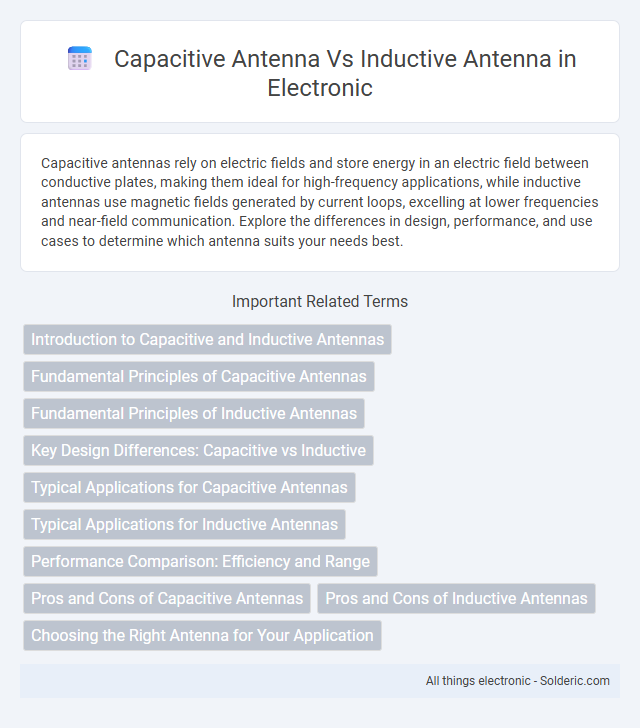Capacitive antennas rely on electric fields and store energy in an electric field between conductive plates, making them ideal for high-frequency applications, while inductive antennas use magnetic fields generated by current loops, excelling at lower frequencies and near-field communication. Explore the differences in design, performance, and use cases to determine which antenna suits your needs best.
Comparison Table
| Feature | Capacitive Antenna | Inductive Antenna |
|---|---|---|
| Principle | Stores energy in electric field (capacitance) | Stores energy in magnetic field (inductance) |
| Structure | Conductive plates or surfaces separated by dielectric | Coiled conductive wire or loop |
| Frequency Range | Higher frequencies, typically RF and microwave | Lower to mid frequencies, RF range |
| Impedance | Primarily capacitive reactance | Primarily inductive reactance |
| Usage | High-frequency applications like capacitive touch sensors | Common in RFID, wireless power transfer, and inductive sensing |
| Advantages | Compact size, good for planar designs | Strong magnetic coupling, efficient at near-field communication |
| Disadvantages | Limited range, sensitive to dielectric environment | Bulkier coils, sensitive to nearby metal objects |
Introduction to Capacitive and Inductive Antennas
Capacitive antennas rely on electric fields generated by a conductive element storing charge, making them ideal for low-frequency and near-field communication applications. Inductive antennas operate based on magnetic fields created by current flowing through a coil, commonly used in RFID systems and wireless power transfer. Both antenna types optimize signal transfer in distinct electromagnetic domains, influencing design choices based on frequency and application requirements.
Fundamental Principles of Capacitive Antennas
Capacitive antennas operate on the principle of storing electrical energy in the electric field between conductors, using a capacitor-like structure to influence signal transmission and reception. Unlike inductive antennas, which rely on magnetic fields generated by current loops, capacitive antennas manage charge accumulation and displacement currents to resonate at specific frequencies. Understanding these fundamental principles enhances your ability to select the appropriate antenna type for applications requiring efficient high-frequency performance or compact design.
Fundamental Principles of Inductive Antennas
Inductive antennas operate based on the principle of magnetic field induction, where a coil generates a magnetic flux that induces current in nearby conductive materials. These antennas are typically used at lower frequencies due to their ability to efficiently couple magnetic energy, making them ideal for near-field communication and RF applications. Understanding the fundamental magnetic field interactions in inductive antennas helps optimize your antenna design for better signal transmission and reception in specific environments.
Key Design Differences: Capacitive vs Inductive
Capacitive antennas rely on electric fields and use conductive plates or surfaces to store and radiate energy, making them effective at higher frequencies with smaller physical sizes. Inductive antennas operate through magnetic fields, utilizing coils or loops of wire to generate radiation, often preferred for lower frequencies due to their efficiency in magnetic coupling. The key design difference lies in capacitive antennas optimizing capacitance for tuning and bandwidth, while inductive antennas focus on inductance and coil geometry to achieve resonance and impedance matching.
Typical Applications for Capacitive Antennas
Capacitive antennas are commonly used in low-frequency communication systems, touch-sensitive devices, and capacitive sensing applications due to their ability to detect changes in electric fields efficiently. Their design excels in portable electronics, RFID systems, and proximity sensing where compact size and sensitivity are crucial. Your projects involving precise electric field detection or near-field communication can significantly benefit from capacitive antenna technology.
Typical Applications for Inductive Antennas
Inductive antennas are typically used in low-frequency applications such as RFID systems, metal detectors, and near-field communication due to their ability to efficiently generate and receive magnetic fields. These antennas excel in environments requiring strong magnetic coupling and are commonly employed in industrial sensors, medical implants, and wireless power transfer systems. Their design favors compact size and robust performance in close-range communication and detection tasks.
Performance Comparison: Efficiency and Range
Capacitive antennas typically exhibit higher efficiency in high-frequency ranges due to lower resistive losses, enabling longer communication range in applications like RFID and wireless sensing. Inductive antennas perform better at lower frequencies where strong magnetic field coupling is critical, often resulting in shorter effective range but more reliable near-field communication. Efficiency of capacitive antennas generally decreases with size constraints, whereas inductive antennas maintain consistent performance in compact designs, influencing their suitability based on operational bandwidth and environmental conditions.
Pros and Cons of Capacitive Antennas
Capacitive antennas offer advantages such as smaller size and better performance at higher frequencies, making them ideal for compact devices and applications requiring efficient signal transmission. However, they tend to have lower efficiency at lower frequencies and can be more sensitive to environmental changes like humidity and proximity to objects. Your choice of antenna depends on balancing size constraints and frequency requirements with the need for stable performance.
Pros and Cons of Inductive Antennas
Inductive antennas offer compact size and efficient performance at lower frequencies, making them ideal for applications like RFID and near-field communication. Their main drawback is limited range compared to capacitive antennas and susceptibility to energy losses due to coil resistance. You should consider inductive antennas when space constraints and close-proximity communication are priorities despite their shorter effective transmission distance.
Choosing the Right Antenna for Your Application
Capacitive antennas excel in high-frequency applications due to their ability to store and release energy efficiently, making them ideal for compact devices and radio frequency circuits. Inductive antennas, characterized by coil structures, perform better in low-frequency scenarios, providing strong magnetic field coupling essential for RFID systems and wireless power transfer. Selecting the right antenna depends on operational frequency, size constraints, and energy transfer requirements specific to your application's electromagnetic environment.
capacitive antenna vs inductive antenna Infographic

 solderic.com
solderic.com